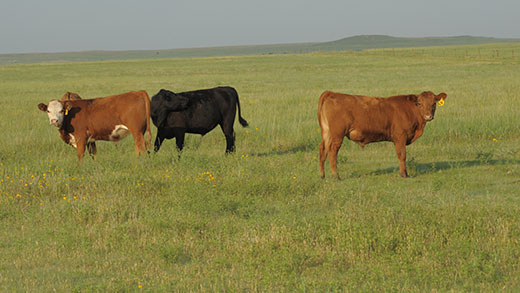
Steers grazing grass as part of a stocker cattle management protocol.| Download this photo.
K-State beef cattle experts discuss tips for raising stocker cattle
Managing feed and health costs while optimizing marketing strategies are keys to success
December 4, 2019
MANHATTAN, Kan. – Cow-calf producers, stocker operators and feedlot managers all have the same end goal in mind: raise high quality beef profitably. Experts at the Kansas State University Beef Cattle Institute say there are many ways that producers can do that successfully.
Stocker cattle are typically newly-weaned calves weighing between 300 and 800 pounds. They are often co-mingled with other calves and developed on a forage-based system with some feed supplementation before moving to the feedlots for finishing.
“Successful stocker operators do a good job of buying and selling the cattle, while keeping them healthy at an effective cost of gain,” said K-State veterinary medicine professor Bob Larson.
In respect to the markets, agricultural economist Dustin Pendell advises stocker operators to follow a buy low, sell high strategy. “There are a lot of considerations to include such as pricing inputs, output price and marketing strategies,” he said. “Producers need to have a risk management strategy when purchasing inputs and selling calves.”
Once the cattle arrive, identifying the appropriate feedstuffs is also going to be key to an operator’s success, according to Larson. “It is not just pricing feed on a per pound of feed basis, but looking at how much growth can come from that feed source.”
For some operations, it may be more cost effective to calculate a slower rate of gain by feeding a forage-based diet, and for others more feed supplementation may be needed to provide adequate nutrients for a faster gain.
K-State Research and Extension cow-calf specialist Bob Weaber also said there is another reason for supplementation. “Following a higher rate of gain may also allow operators to meet a marketing window due to the seasonality of feeder calves,” he said.
Along with market price considerations and feeding strategies, the experts agreed that it is vital to follow a health protocol for the calves.
“It is important to establish a logical plan of first and second treatments,” Larson said. “The veterinarian is going to help select an antibiotic that is a good match for the bacteria that is causing the disease.”
Another part of the plan is to outline treatment frequency, and establish a second protocol for those that don’t respond to the initial treatment.
Larson stressed the importance of sticking with the treatment plan. “This is a protocol. Treat every animal the same so we can evaluate if this protocol is working,” he said.
More information on this topic is available on a weekly podcast produced by the Beef Cattle Institute.
